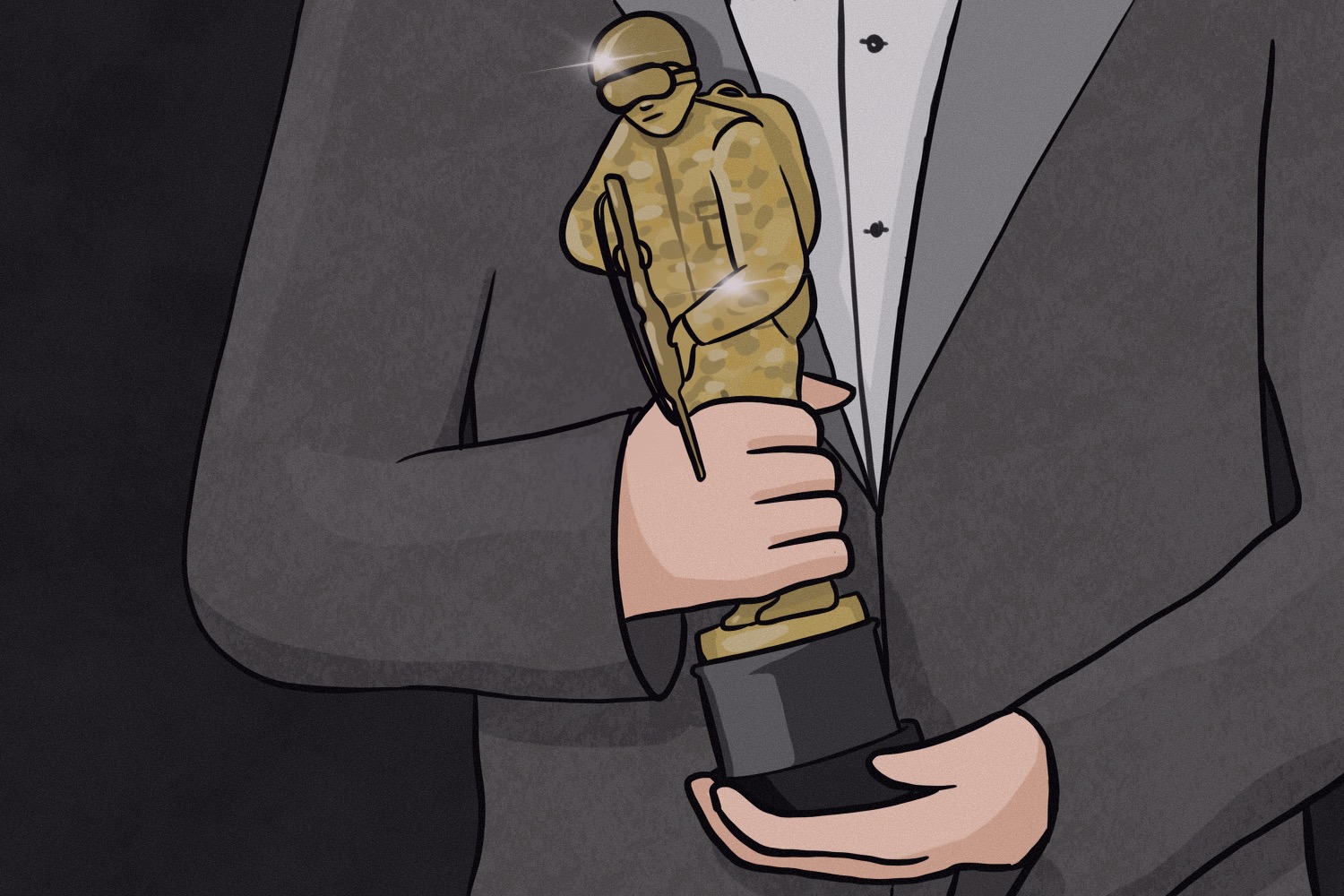War films have been of particular interest to the Oscar Award judges for decades and are now notoriously considered “Oscar bait.” Oscar bait describes films that are specifically catered to what Oscar Award judges typically consider hallmarks of cinematic masterpieces such as world catastrophes and tragedies, most notably World War I and World War II films. Oscar bait also tends to glorify the narratives of Western violence, depicting European and American men of history as heroes and “good guys,” perpetuating a biased recollection of racialized history and war.
This year’s Oscar Award for best picture predictably went to Christopher Nolan’s “Oppenheimer,” which has won numerous awards, including a Screen Actors Guild Award (SAG) and a British Academy Film Awards (BAFTA) trophy for best picture, actors and more. The film, though not directly related to bloody battle scenes, follows physicist J. Robert Oppenheimer (Cillian Murphy) as he develops the U.S. atomic bomb during World War II.
Nolan’s 2018 war film, “Dunkirk,” was also nominated for Best Picture awards and won Oscars for its editing and sound mixing. “Dunkirk” followed the narrative of British soldiers during the intense Battle of Dunkirk in France during World War II, but it excluded portrayals of Indian and Black soldiers who also fought during said war, limiting the lens of war heroes as white men.
Both of Nolan’s films encourage viewers to empathize with the lives of Western soldiers or scientists, often depicting them overcoming tribulation. “Oppenheimer” depicts the life of J. Robert Oppenheimer as both accomplished yet tragic due to his development of the most dangerous weapon of mass destruction which killed over 200,000 Japanese citizens, many of them innocent civilians.
While J. Robert Oppenheimer spirals in guilt because of the Hiroshima and Nagasaki bombings, for which his atomic bomb was used for, viewers are asked to empathize with him now that he realizes how detrimental his violent creation is. Though he previously advocated for the protection of allied forces by actively and willingly developing the atomic bomb, his character is redeemed towards the end of the film simply because he feels guilt.
The Oscar judges ate up this story of another distressed white man during war and gave it the film the Best Picture award. Rewarding the cinematic art of white narratives during war presents two problems: 1) praising white-washed perceptions of multi-ethnic global violence and 2) silencing narratives of violence that do not directly involve Europe or the U.S.
Out of the 22 “war” films that have won an Academy Award for Best Picture, only two of them revolve around non-western stories: “The Last Emperor” and “Gandhi.” The irony is that both films contained many historical inaccuracies and were criticized for overtly negative portrayals of key Asian figures, in this case, China’s last emperor Pu Yi, and Indian activist Mahatma Gandhi. Both films were also directed by white men who ultimately reaped the most benefit from inaccurately portraying Asian history. Such patterns are also found within Vietnam War films, such as “Rambo First Blood Part II,” that showcase the Vietnamese in a primitive and dehumanizing manner.
The narrative of the European and American “good guys” is present within the majority of Oscar winning/nominated war films such as “1917,” “Hacksaw Ridge,” “All Quiet on the Western Front,” “Saving Private Ryan,” “The Bridge on the River Kwai” and so on.
Even though “All Quiet on the Western Front” follows a German soldier (the “bad” guy), he is depicted as a poor victim of Nazi manipulation who is “less bad” because he was coerced into idealizing violence. As an Oscar winner, the film was commended for being “anti-war.” The film is a distorted perception of violent Nazis, redeeming some of them simply because they feel guilty after their crimes. This is a grossly distorted perception of how innocent Europeans were creating tales of “bad guys” who can’t be held accountable for their violence because they regretted their choices afterwards.
American war films such as “Hacksaw Ridge” and “The Bridge on the River Kwai” depict the Japanese as horrific one-sided perpetrators of violence. While it is historically true that the Japanese antagonized the U.S. first via the Pearl Harbor bombings, they were no worse than the U.S. in their expansive ideology. Americans found the Japanese conquest of Asia disdainful, yet owned the Philippines until 1946.
Why do the Oscars fail to recognize the stories of Japanese soldiers who were also manipulated into violent agendas? Why don’t viewers receive empathetic stories from the Asian enemy rather than the German one? Why is the Asian conquest of the world bad, but the American one excused?
“The Bridge on the River Kwai” films Japanese camps in Thailand as monstrosities against innocent American soldiers, depicting a one-sided narrative of forced labor camps. Such a Western scope dismisses the harm of the U.S. Japanese internment camps that persecuted Japanese-Americans who had nothing to do with the war except for simply being Japanese.
In fact, some Japanese-Americans fought against their home country’s axis alliance despite facing profiled xenophobia.
Yet, the Oscars choose to reward films that redeem some Nazis and victimize American soldiers against the Japanese. The Oscars do not want Americans to empathize with the Japanese, though, nor do they even care to showcase narratives of other Asians who were attacked by the Japanese —only Americans.
With a 92% rating on Rotten Tomatoes, the film “City of Life and Death” reveals the horrifying massacre of China’s Nanking city, where thousands of women were assaulted and killed. Unfortunately, the film made virtually no traction in the U.S or Europe, ignoring non-white sufferers of war.
Films with no relation to Westernized war are dismissed entirely. The film The Woman King tells the story of an all-female battalion of African warriors protecting their land, earning a 94% rating on Rotten Tomatoes with less traction than Oppenheimer.
While “Oppenheimer” made a whopping 500 million dollars in box office profits (the most for any WWII film), “The Woman King” neared 100 million, and “City of Life and Death” only reached 10 million. Commercial statistics can reveal a lot about which narratives people prioritize the most.
“Da 5 Bloods” detailed African American soldiers during the Vietnam war and had a 92% Rotten Tomatoes rating, yet was only nominated for one Oscar for original score, dismissing the work of the storytelling behind the profound work of Black soldiers during the war. The erasure of soldiers of color from award recognition also perpetuates the idea that the ideal poster child for America’s war heroes are white soldiers.
Circling back to this year’s Oscar awards, “Killers of the Flower Moon,” which depicts the Osage Tribe massacre of Indigenous women by white men, was snubbed. Though it received 10 nominations, it won no Oscar awards despite its success at the SAG and BAFTA awards. It’s truly frustrating to either be teased with diverse Oscar wins or have them excluded entirely.
Ultimately, the Oscars have half-heartedly attempted to increase “diverse” narratives, playing it safe with which parts of history it wants to hold Westerners accountable for. Now that Indigenous disenfranchisement is becoming a widely accepted truth, the Oscars have no problem highlighting it, but because the blame behind 20th century wars still favors the U.S., the Oscars choose to maintain this favorable bias towards America.
In summary, the Oscar awards fail audiences who wish to see themselves represented more throughout history. It repeatedly demonizes and ignores ethnic countries during war while teaching people that a Western perspective is the most accurate and important to believe.
At this point, the Oscars might as well be Hollywood propaganda, as the only cinematic masterpieces that take home trophies are primarily white. The Oscars also have majority -white judges. Without different voices in the Oscars judge panel, Hollywood will continue to limit the scope of who is bad, good, accountable and redeemable during mass violence, covering up the distasteful truths of Western history. How does the Oscars’ whitewashed board continue to Whitewash history through film?

















